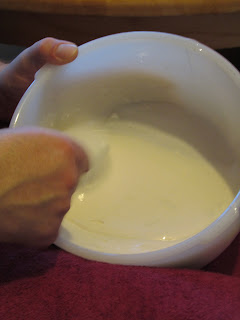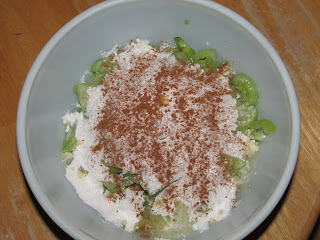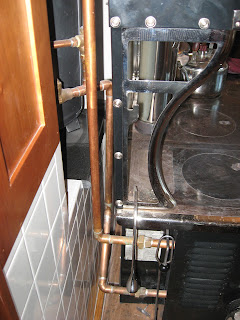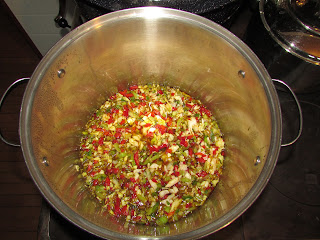Harvest is finished here in the Corn Belt, and it seems like this would be a very appropriate time to talk about using corn cobs as fuel in a woodburning cookstove. Cobs were an extremely popular cooking and heating fuel in the Midwest for a long period of time, but despite the fact that in this day and age more cobs are produced annually than at any other time in history, using them as fuel has become obsolete.
Some Basic Information about Corn Cobs--
First, let me explain what a corn cob is for those who are not familiar with the corn plant--especially since this blog has international readership. What we Americans call corn is really more properly known as maize. It is considered the most domesticated crop in the world. Technically classified as a grass, the seeds of the plant grow on something called an "ear." An ear of corn grows inside of tightly connected leaves called "husks." The next layer inside the husk is several hairlike strands called the "silk." The silk is what catches the corn pollen and transports it to the corncob, where the kernel of corn is formed.
 |
| An ear of ripe corn complete with husk and silk. |
Originally, corn was harvested by picking each ear by hand. By about 1940, most farmers had gone to mechanical corn pickers that still picked the entire ear. Corn could either be fed as whole ears to cattle and hogs, or the corn would be "shelled" (removing of the corn kernels from the cob) later and fed to livestock whole or ground, or sold as a cash crop.
In our area, it was around 1970 when most farmers switched from harvesting corn by picking the whole ear to using machines called "combines." A combine is so named because it
combines the processes of picking the ear and shelling the corn all as it travels through the field. The empty corn cobs are sent out the back end of the combine along with bits of stalk, husk, and leaves to fall roughly where they grew, becoming a part of the "crop residue" that is left in the field to return nutrients to the soil and prevent erosion. However, compared to the leaves, husks, and stalks of the corn plant, the cob is of little value as crop residue.
The corn cob is rough in texture and lightweight. It feels a little like a tube of tightly rolled paper. Because the cob is also fibrous, moisture affects it easily. Cobs dry quickly, but they also are very absorbent and can quickly become wet even when simply exposed to high humidity.
Because of this light, fibrous structure and rough texture which creates an abundance of surface area, dry corn cobs ignite quickly. They burn very hot and very fast, leaving only short-lived embers behind.
Historical Use of Corn Cobs as Fuel--
As American settlers moved westward into the plains states, trees were fewer and farther apart, so pioneers began to turn to other fuels besides wood in order to do their heating and cooking. We've all heard stories of them using "prairie coal," which was a fancy name for buffalo chips or cow chips. The word "chips" itself is a euphemism for the dried dung of these animals. I've actually burned some cow chips in my cookstove, and they don't work too badly, but I'd have to admit that the smoke does not have a very pleasant odor.
Settlers would also use dried grass (hay) as fuel by twisting it into bundles called "cats." Special cooking stoves were even designed in order to facilitate burning hay more efficiently and conveniently.
However, as more and more acres came under corn production, the corn cob became the prairie fuel of choice. Abundant, cheap, relatively clean to handle, and easy to ignite, the corn cob enjoyed wide use as fuel across the Great Plains for many decades.
This article shows how largely the cookstove and the corn cob affected life here in earlier days. It is also important to note that before the advent of the chain saw, harvesting firewood was a much more arduous task than it is today, making the corn cob even more desirable fuel because once the corn has been shelled, the cob is ready to be burned.
Historical accounts of life on the Great Plains are replete with stories about burning corn cobs for heating and cooking. In some research that I did about the Schoolchildren's Blizzard of 1888, many of the memoirs mentioned corn cobs being the only fuel that was used in the farm homes of rural Nebraska. Some also talked about the fact that their schoolhouses were heated with cobs which the different families in the district took turns furnishing.
 |
This is a Library of Congress photo of a Mrs. Emma
Bettenhausen pouring corn cobs in her kitchen range
in Nov. 1940. She lived in McIntosh County,
North Dakota. |
Burning corn cobs in cookstoves became such a common thread in the fabric of rural life that last summer when I met veteran Southwest Iowa radio homemaker
Evelyn Birkby, who is still broadcasting on KMA in Shenandoah at the age of 98, the first thing she said upon finding out that I cook on a woodburning range was "Then you know exactly how many corn cobs it takes to bake an angel food cake."
This made me think of my aunt Ellen's mother Dorothy. As a young girl, it was Dorothy's job to stand by the open firebox door of her mother's wood cookstove and shove one cob into the fire at a time in succession in order to maintain even oven heat while her mother was baking. (I don't doubt that this story is true, but it does seem to me like keeping the firebox door open constantly would have absolutely ruined the efficiency of the fire because of the spoiled draft. Perhaps this was the only solution Dorothy's mother had found for a cantankerous stove.)
The fact that corn cobs were so widely used as cooking fuel was not lost on the retail establishments of the day, either. My copies of vintage Sears catalogs show that as late as the 1920s, corn cobs were listed alongside wood, coal, coke, and rubbish as possible fuels for their ranges. Some of the earlier catalogs even list "chips" among their fuels.
The architecture of farm buildings was even affected by the use of corn cobs for fuel. Due to the fact that cobs can take on moisture so easily, it was important to keep cobs sheltered so that they would remain dry for burning. On our farm, the combination wash house/garage (a wash house was a building separate from but near to the house where the weekly chore of clothes washing was completed) was outfitted so that its second story was used for cob storage. I'm told that the cobs were delivered to the wash house side of the first floor via a chute that emptied into a bin somewhere near the laundry stove.
A similar setup was built at Nancy's grandparents' farm. Their wash house was divided into two rooms. The north room was for cob storage. Cobs were shoveled into a small door at the top of the north wall. They were accessed on the wash house side through a people-sized door which was to the right of the stove. When they broke up housekeeping in 2010, I sifted through quite a few cobs which were still there in order to salvage the anthracite coal which was also stored in that room.
At the house where my maternal grandmother lives, a building called "the cob house" stood just inside the back gate between the driveway and the kitchen. One side of it was used to store corn cobs, and the other side housed a Delco Light Plant. The Delco generator was removed with the arrival of Rural Electrification in our area in the 1930s, but the corn cobs remained in use for cooking and water heating for at least another decade.
My paternal grandmother lived on a farm just over the hill from where Nancy and I live, and she told me that their cobs were stored in a lean-to which was attached to their wash house. She said that somehow or other the corn cobs caught fire, and the whole building was quickly reduced to ashes. She remembered that the fire was particularly hot because of the corn cobs.
My great-great aunt Meme (born in 1895 and mentioned in the About Me section to the left) never married and remained on the home farm with my great-great grandparents until they moved in order to make room for my newlywed grandparents in 1947. At sometime during the mid-1920s, the large, beautiful farmhouse that they lived in was equipped with hot running water furnished by a Monarch range in the kitchen, but during hot days in the summer, they had a three burner kerosene stove that they cooked on. She frequently reminisced with me about her early life, and I remember her talking about the fact that after a hot summer's day of outdoor work, she would build a corn cob fire in the green and cream Kalamazoo cookstove in their summer kitchen, heat a teakettle of rainwater, and use that to take a bath in a washtub. The corncob fire was perfect for this since it was quick to kindle but did not linger after it had served its purpose.
Meme also talked about how she and her brother and sister hated to gather corn cobs. Of course, if the corn had been shelled to feed to poultry or to sell, those corn cobs were not difficult to collect. However, ear corn was fed to hogs by just giving them the whole ear. The hogs would chew the corn off the cob and leave the corn cobs lying about their pen. It was the kids' job to get into the hog pen and retrieve the scattered cobs, which would often be quite dirty, not to mention the fact that hogs can be pretty ornery, too.
In order to maximize the capacity of a bushel basket (commonly called "cob baskets" when hauling this cargo was their primary function), it was the practice among some farm families to stand cobs vertically in a ring around the outer edge of the basket.
 |
My cob basket filled and stacked in the old fashioned
way. You'd be amazed at how long it took to pick up
this many cobs in the harvested field. |
Cob baskets were often put on the floor next to the firebox side of the stove to make fueling easier. Unfortunately, this could be a dangerous situation since cobs catch fire so easily. In antique cookbooks, it is not uncommon to see warnings about keeping the cob basket a safe distance from the range.
I once had to interview my paternal grandparents about life during the Great Depression. In the course of the conversation, Granny told me that the price for corn dropped so low that her parents began to burn not just corn cobs, but whole ears of corn. (I don't know why they wouldn't have burned wood instead.) Gramps agreed that many farmers did that and said that he remembered his folks tried it too, but they found it too depressing. I can understand that since in those days so much of the work of corn production was done by hand.
How I Use Corn Cobs Today--
Corn cobs burn just as well today as they did in the past, and as I said, there are many more of them available per field than ever before. However, two things have changed which have made them less desirable as fuel for me. The first is that they are no longer a common by-product of regular barnyard chores. Thus, in order to collect enough of them to make any size fire, one has to spend a lot of time bent over picking them up off the ground. The second change is the construction of wood cookstove fireboxes. The traditional design of a wood cookstove included a firebox depth that was usually less than twelve inches. This kept the fire very near the cooktop, making the use of corn cobs very efficient. The depth of the Margin Gem's firebox makes it so that I would have to have a quite a lot of cobs burning in order to raise the temperature of the stovetop sufficiently to do any type of cooking.
Since it is a traditional cookstove, the firebox of the Riverside Bakewell in our summer kitchen is well suited to burning corn cobs. You can see what a corn cob fire looks like in the Riverside Bakewell in the picture below.
 |
A corn cob fire in the Riverside Bakewell cookstove. I was
canning brown rice and cooking chicken when this photo was
snapped. |
My favorite use for corn cobs now is for starting the fire. The addition of a few dry corn cobs to the usual sticks of kindling when lighting a fire insures that the fire will start without any difficulty. Until this year when she turned ninety, my maternal grandmother would collect all of the stray corn cobs that would find their way into her barnyard on farm machinery and send them to me in boxes, cat food sacks, or milk cartons that she would cut open. I always appreciated getting them because it was sort of the same as receiving fire-starting insurance from her.
Somehow I doubt that we will ever see widespread use of the corn cob as household fuel again, but I did run across
this article about using corn cobs in commercial coal-powered power plants that I thought was very interesting. The article is almost ten years old, however, and I would like to try to find some follow-up information. The article also talks about the corn cob harvesting implement that can be attached to the back of a combine in order to save the cobs as well as the grain. Maybe I'll have to buy one for my brother for Christmas! (Sorry, Kev. Way out of our budget.)
Anyway, please use the comments section to share your memories about burning corn cobs in a kitchen range, or--especially if you live outside the Midwest--tell about whether corn cobs were ever used as fuel in your area of the world, or if you still burn cobs, talk about that too!























































